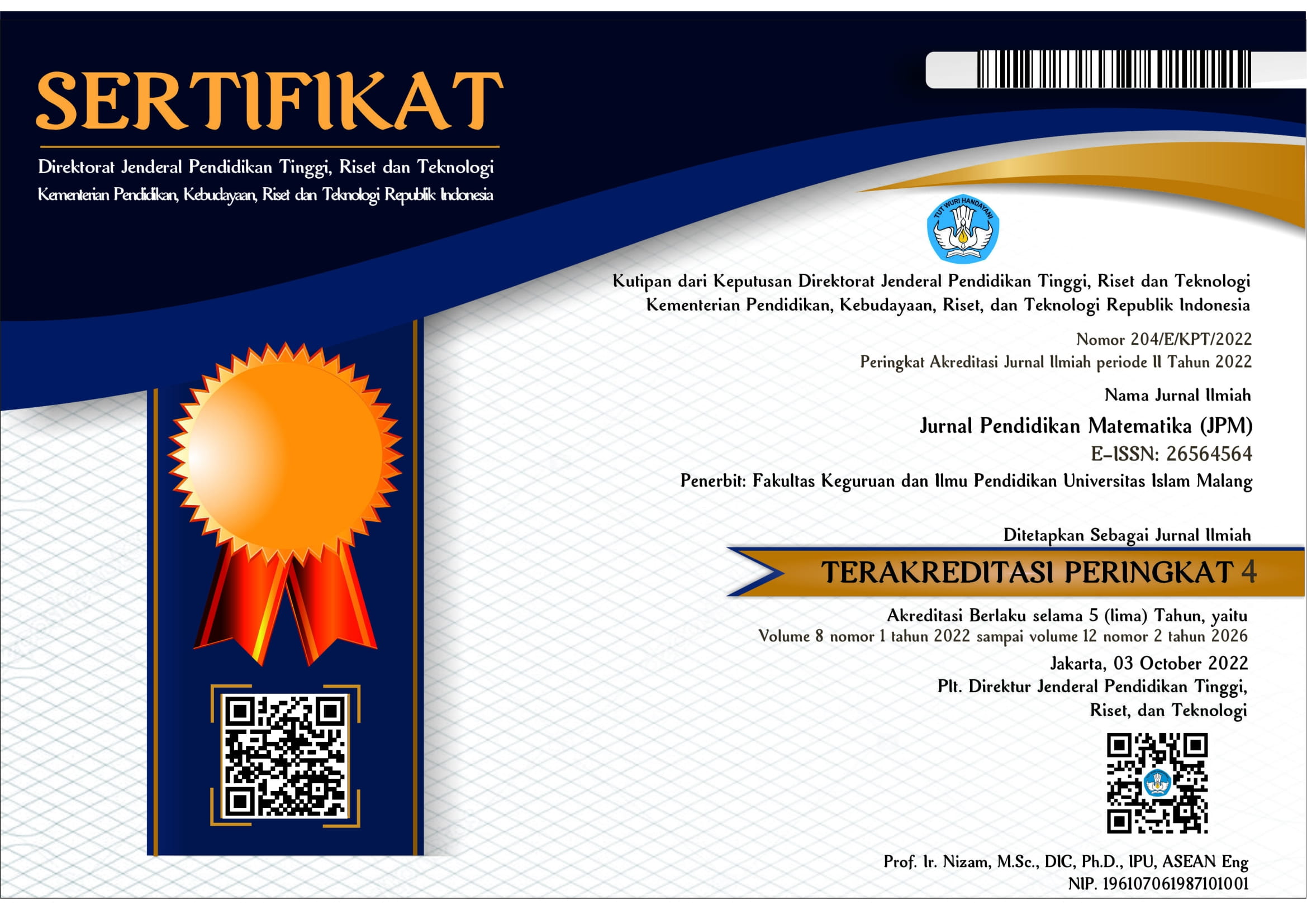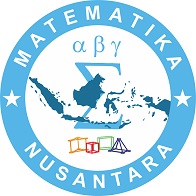BERPIKIR ANALITIK MAHASISWA DALAM MENGONSTRUKSI BUKTI SECARA SINTAKSIS
DOI:
https://doi.org/10.33474/jpm.v2i2.196Keywords:
Berpikir Analitik, Bukti, Sintaksis.Abstract
Fenomena menunjukan kegagalan mahasiswa dalam mengonstruksi bukti secara sintaksis dikarenakan mahasiswa tidak berpikir analitik. Kemampuan mahasiswa dalam mengonstruksi bukti sangat menentukan keberhasilannya mempelajari matematika tingkat lanjut, sehingga penelitian untuk mengungkap fenomena ini penting dilakukan. Penelitian ini bertujuan mendeskripsikan berpikir analitik mahasiswa dalam mengonstruksi bukti secara sintaksis. Untuk mengetahui berpikir analitik mahasiswa, peneliti memberikan masalah pembuktian kepada sekelompok mahasiswa yang telah menempuh Geometri. Dilihat dari keanalitikan jawaban mahasiswa, peneliti menemukan tiga kategori berpikir, yaitu; (1) analitik, (2) semi analitik, dan (3) pre analitik. Berpikir analitik ditandai oleh adanya konstruksi bukti yang jelas, kejelasan algoritma, keruntutuan penalaran, penggunaan simbol secara tepat, setiap pernyataan dilandasi oleh alasan yang tepat dan langkah yang efektif. Berpikir semi analitik ditandai oleh adanya “elemen pengganggu†pemutus rantai implikasi. Berpikir pre analitik ditandai oleh penggunaan gambar sebagai bukti.
Kata Kunci : Berpikir Analitik, Bukti, Sintaksis.References
Alcock, L.Inglis, M. 2010. Visual Consideration In The Presentation Of Mathematical Proofs. International Journal of Media, Technology and Lifelong Learning, 6 (1): 43 – 59.
Amer, Ayman, dkk. 2005. Analytical Thinking. Cairo: Center for Advancement Studies and Research in Engineering Science, Cairo: Faculty of EngineeringCairo University.
Chen,Y. 2008. From formal proofs to informal proofs-teaching. International Journal of Case Method Research & Application. New Britain, Connecticut, U.S.A. : Central Connecticut State University.
Hanna, G., & Barbeau, E. 2008. Proofs as bearers of mathematical knowledge. Zentralblatt für Didaktik der Mathematik, 40(30), 345–353.
Healy, L. & Holyes, C. 1998. A study of proof conceptions in algebra. Journal for research in mathematics education, 31 (4) : 396 – 428.
Leff, L., S. 2009. E-Z Geometry. New York: Barron’s Educational Series.
Lewis, H. 1968 Geometry A Contemporary Course. New York: D. Van Nostand Company, Ltd.
Montaku, S., dkk. 2012. The Model Of Analytical Thinking Skill Training Process. Research Journal of Applied Sciences 7 (1) 17-20, 2012 ISSN: 1815-932X. Medwell Journal.
Montaku, S.. 2011. Results of Analytical Thinking Training Through Students in System Analysis and Design Course. Proceeding of the IETEC’11Conference, Kuala Lumpur, Malaysia.
Mulyati, S. 1999. Segitiga dalam Geometri. Malang: Departemen Pendidikan dan Kebudayaan Universitas Negeri Malang.
Musser, G.L. & Burger, W.F. 1994. Mathematics for Elementary Teachers; A Contemporary Approach, third edition. New York; Mac Millan Publishing Company, Inc.
NCTM. 2000. Principles and Standards for School Mathematics. United States of America: The National Council of Teachers of Mathematics, Inc.
Orton, A. 1992. Learning Mathematics: Issue, Theory and Classroom Practice. London: Cassel.
Parta, I. N. 2016. Karakteristik Berpikir analitik Mahasiswa dalam Menyelesaikan “Masalah Sederhanaâ€. Malang: Universitas Negeri Malang.
Pinto, MMF. 1998. Students’ Understanding of Real Analysis. Unpublished PhD Thesis. Warwick, UK: University of Warwick.
Recio, A.M. & Godino, J.D. 2001. Institutional and Personal Meanings of Mathematical Proof. Educational Studies in Mathematics, Volume 48: 83-99.
Robbins, J. K. 2011. Problem solving, Reasoning, andAnalytical Thinking in a Classroom Environmen. Jurnal ISSN: 1555-7855 Vol. 12, No.1, page 40-47. Morningside Academy and Patnerships for EducationalExcellence and Research, International.
Ruseffendi, E.T. 1980. Pendidikan Matematika 3. Jakarta: Depdikbud.
Shelden, A. J. & Selden. 2003. Validation of Proof Consideren as Texts: Can Undergraduates Tell Wether an Argument Proves a Theorem? Journal for Research Mathematics Education, 34(1):4-36.
Stylianou, D.A., Blanton, M. L., Knuth, E. J. 2009. Teaching and Learning Proof Across the Grades. New York: Routledge.
Tall, D.O. 2009. Cognitive and Social Development of Proof Through Embodiment, Symbolism & Formalism. Dalam Lin, Fou Lai (eds). Proceeding of The ICMI Study 19 Conference: Proof and Proving in Math-ematics Education, Vol 2. Taipei: The Department of Mathematics, National Taiwan Normal University.
Varghese, T. 2009. Secondary-level Student Teachers' Conceptions of Mathematical Proof. Issues in the undergraduate Mathematics Preparation of School Teacher : The Journal, 1: 1 - 14
Weber, K. 2001. Student Difficulty in Constructing Proofs: The Need for Strategic Knowledge. Educational Studies in Mathematics, Volume 48: 101-119.
Weber, K. 2004. A Framework for Describing the Processes That Undergraduates Use to Construct Proofs. Proceedings of the 28th Conference of the International Group for the Psychology of Mathematics Education, Vol 4 pp 425–432.
Weber, K., & Alcock, L. (2004) Semantic and syntactic proof productions. Educational Studies in Mathematics, 56, 209–234.
Windsor W.J.J., M.Ed. 2008. Algebraic Thinking- More to Do with Why, Than X and Y. Queensland: Griffith University.
Zazkis, R., Gholamazad, S., & Liljedahl, P.. 2003. One Line Proof: What Can Go Wrong?. Proceeding of the 27th Conference of The International Group for the Psychology of Mathematics Education, 2, 437 – 444. Honolulu, HI.





_-_Copy.jpg)
.jpg)
.jpg)










